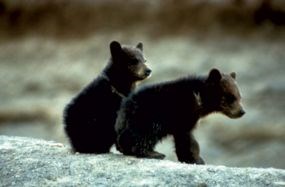
NPS/Neal Lewis 
NPS Photo IntroductionThe American Black Bear lives throughout much of the continent, including northern Canada and Alaska south into Mexico, and from the Atlantic to the Pacific. Black bears are the only species of bear found in Shenandoah National Park. While there were probably once as many as two million black bears in North America before European colonization, the population declined to a low of 200,000 as a result of habitat destruction and hunting. By the early 1900s, bear populations were nearly eliminated from lands that are now within the park. On the eastern side of the Blue Ridge, the last bear was reported in Albemarle County in 1910. Bear populations persisted however in the Allegheny Mountains to the west, the descendents of which are the most likely source of the current park population. Physical DescriptionMale black bears (boars) are between five and six feet long and two to three feet tall and they typically weigh between 100 and 300 pounds. Females (sows) range in weight between 100 and 175 pounds. Cubs usually weigh between seven ounces and one pound at birth. The adult black bear has small eyes, rounded ears, a long snout, a large body, and a short tail. As their name indicates, these bears generally have shaggy black hair. Black bears walk on the soles of their feet and have non-retractable claws. Life Span and ReproductionBears in the Park enter winter dens in October and November, but some may roam about all winter if temperatures are mild. Females will have their cubs around February and nurse them in the den. They will emerge in April or May, usually after the adult males have been out of their own dens for a while. Black bears are not considered to be true hibernators but they do not eat, drink, defecate, or urinate while denning. They may be easily aroused from their dens. Habitat and RangeBlack bears generally require large areas of diverse habitat to thrive. Bears are particularly successful at Shenandoah National Park because the park provides large areas of contiguous, high quality, forest habitat. Stands of mast producing trees (most importantly oaks) continue to mature and in good years are producing ever larger acorn crops. 
http://www.dgif.virginia.gov/wildlife/bear/ BehaviorBears are most active at dawn and dusk but also are seen by visitors during daylight hours.They have a keen sense of smell, hearing, and eyesight at short distances. Eyesight at longer distances is poor. DietAlthough they are carnivores, their diet is quite varied and they tend to be opportunistic. They will eat grubs and other insects, roots, flowers, grasses, acorns, fruit, and carrion, as well as groundhogs, deer, and other small mammals. Feeding during the fall is intense with one to two pound gains per day. Bears will raid orchards, beehives, and agricultural crops. They also frequent garbage dumps or may raid the trash bins of businesses or private homes. Black bears may occasionally prey on domestic sheep and pigs when their natural foods are scarce. Ecosystem RoleBlack bears are at the top of the food chain. As a result, they eat animals that are more readily captured due to age or weakness caused by injury or illness thus having some influence on population dynamics of some species. Foraging activities by bears probably help with decomposition in forested environments where they tear apart logs and snags to gain access to insects or where they may excavate plants from the ground. Their consumption of berries, and fruits aids in the distribution of the seeds of various plants. ThreatsBlack bears are thriving in Shenandoah National Park and in Virginia as a whole. Nevertheless, threats to this iconic animal do exist. Habitat destruction and expansion of suburban areas can result in reduced habitat quanitity or quality for bears. In addition, increasing human populations in conjunction with increasing bear populations can lead to negative interactions that may harm individual bears. For example, when human garbage isn't stored properly, black bears view it as a food source and may become a problem in residential areas. These animals may then need to be destroyed by wildlife officials. In addition, poaching, or illegal killing, is also a threat to black bears in Virginia. In some parts of the world, bear gall bladders and paws are believed to have traditional medicinal value, and this has led to a lucrative market in these items - a market which ultimatley increases poaching of bears. The Convention of International Trade in Endangered Species of Wild Fauna and Flora (CITES), a treaty among more than 120 nations, provides measures to curb illegal trade in wildlife and wildlife products across international boundaries, help to protect the black bear from poaching. Living With Black BearsAs indicated above, black bears can become a nuisance when they seek sources of food and come in close contact with people. The National Park Service has taken extensive measures to keep bears and people separated from one another. Review how to enjoy bears safely. When visiting the park you have a responsibility to keep your distance from the bears, not attempt to feed any wildlife in the park, and to properly handle, store, and dispose of your food and garbage. When backcountry camping make sure to store food in an approved bear-resistant food canister. Visit the Virginia Department of Game & Inland Fisheries to learn about living with Black Bears In Virginia. Black Bears in National Parks |
Last updated: April 25, 2022
